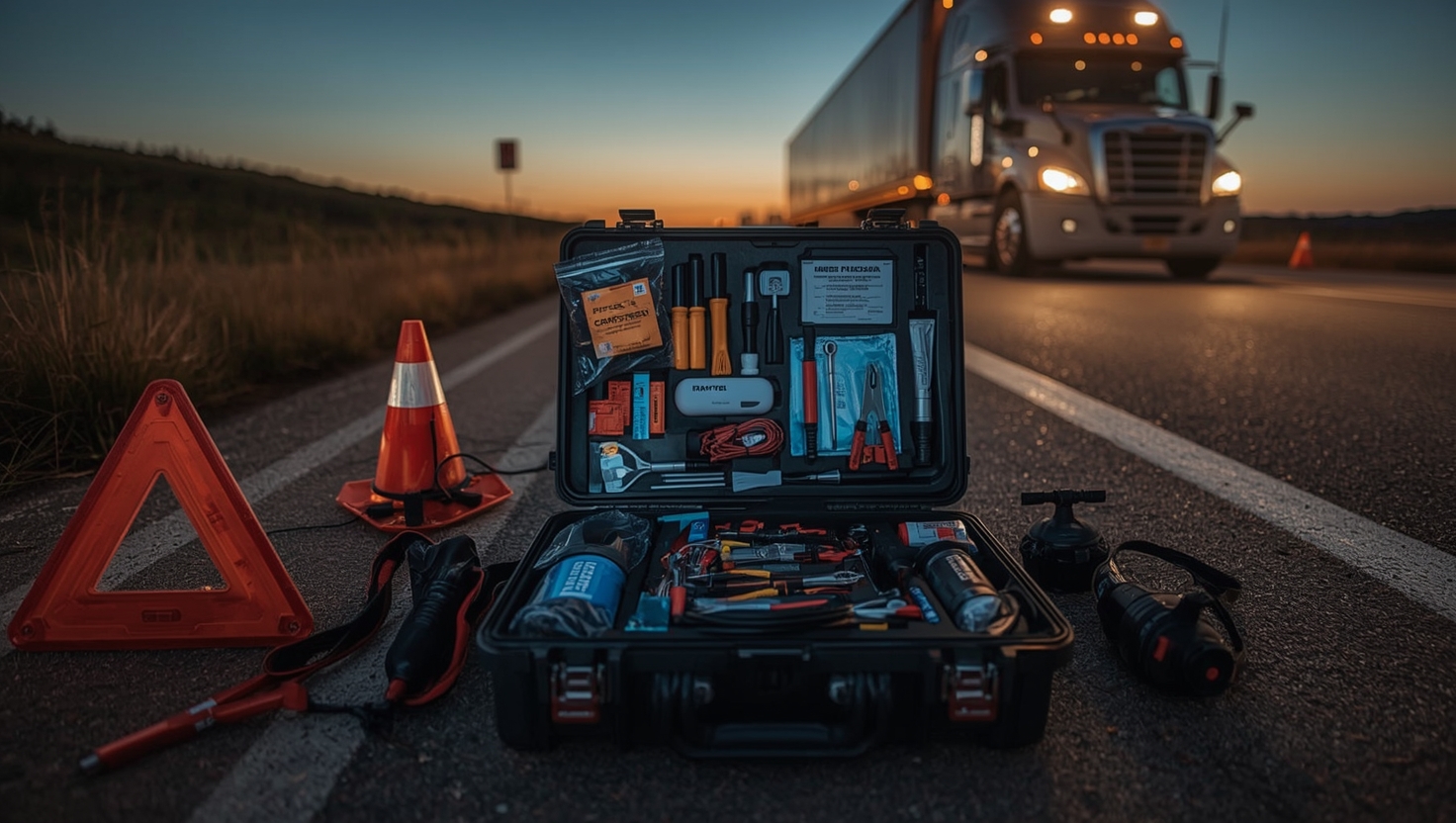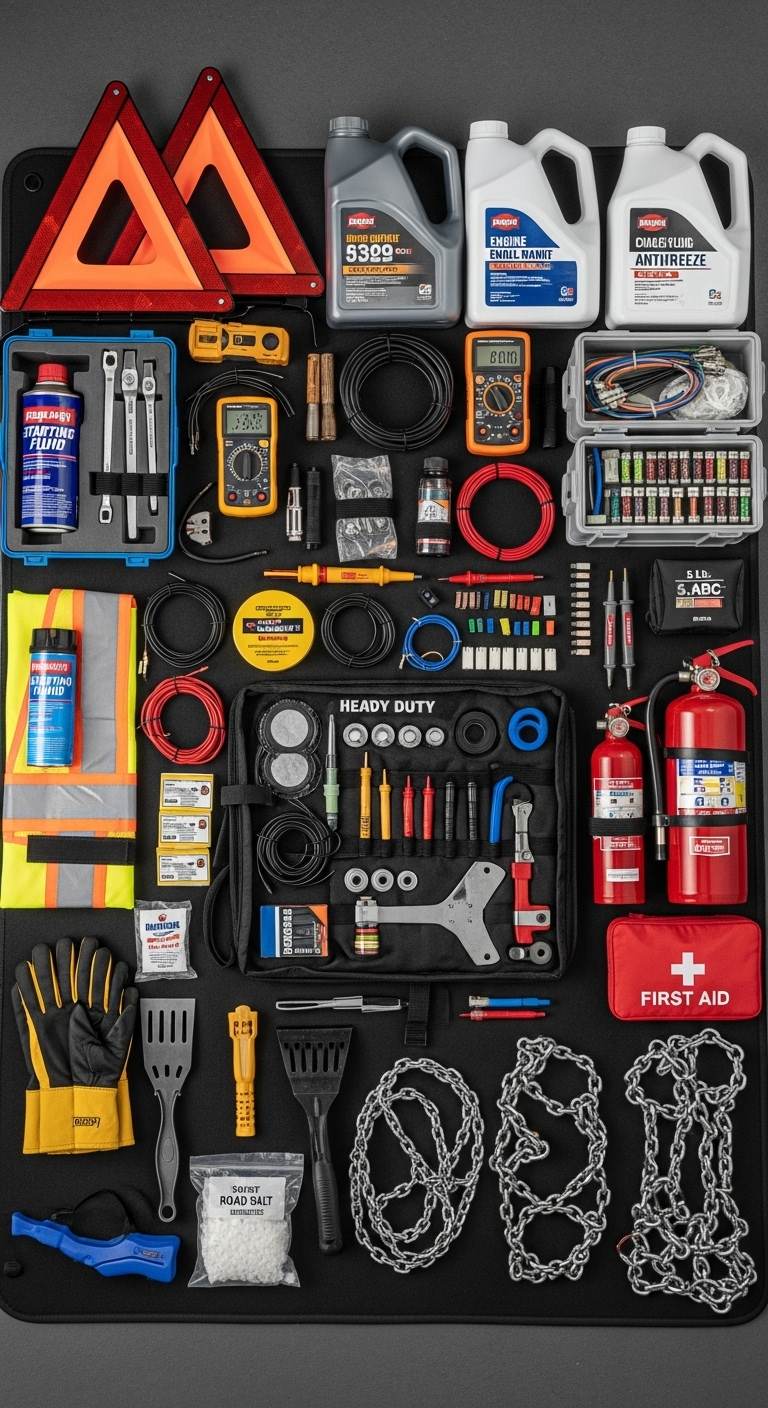Whether you’re shipping standard pallets or large industrial equipment, learn about the wide range of freight solutions we offer to meet any challenge.
Every commercial driver eventually faces a roadside emergency. Whether it’s a flat tire on I-95, a blown fuse in the George Washington Bridge tunnel, or a coolant leak on the New Jersey Turnpike, having the right tools aboard can mean the difference between a 20-minute fix and a six-hour wait for service.
This guide covers the essential emergency toolkit every commercial driver should carry, optimized for medium and heavy-duty trucks operating in the Northeast corridor.
A well-stocked emergency kit turns a roadside breakdown from a nightmare into a 20-minute delay. Preparedness isn’t optional—it’s the difference between control and chaos.
DOT-Required Safety Equipment
Before discussing tools and supplies, ensure your truck carries federally mandated safety equipment. FMCSA regulations require:
Warning Devices – Three reflective triangles, six fuses or three liquid-burning flares. Place triangles 10 feet, 100 feet, and 100 feet behind your vehicle (200 feet total spread) on two-lane roads, or 10 feet, 100 feet, and 200 feet on divided highways.
Fire Extinguisher – Minimum 5-B:C rating, properly charged and mounted securely. Check pressure gauge monthly. Expired or discharged extinguishers result in DOT violations.
Spare Fuses – One complete set matching all fuses in your truck, stored in a labeled container. Know fuse panel locations for lights, accessories, and critical systems.
These items aren’t optional—roadside inspections check for them, and violations result in fines and out-of-service orders.
Tier 1: Essential Hand Tools (Always Carry)
Adjustable Wrench (12-inch) – Handles most bolt sizes from 3/8″ to 1″ for mirror adjustments, battery terminals, and accessory mounts. Chrome vanadium steel resists corrosion from road salt.
Socket Set (1/2″ Drive, Metric & SAE) – 10mm through 19mm and 3/8″ through 3/4″ cover lug nuts, suspension bolts, and brake components. Include deep sockets for recessed nuts. Freightliner and Hino trucks predominantly use metric.
Ratchet & Breaker Bar – 18-inch breaker bar provides leverage for seized bolts. Pair with a quality ratchet featuring 72-tooth mechanism for tight-space work.
Screwdrivers (Flathead & Phillips) – Multiple sizes from precision electronics to heavy-duty 1/4″ shafts. Electrical panels, battery boxes, and interior components need various driver sizes.
Pliers Set – Standard slip-joint, needle-nose, and locking pliers (Vise-Grip style). Critical for electrical connections, hose clamps, and seized components.
Hammer (2 lb Ball Peen) – Tapping stuck brake drums, aligning components, and freeing frozen adjusters. Avoid excessive force that damages threads or castings.
Pry Bar (18-inch) – Separating stuck components, aligning holes, and removing hubcaps. Flat and tapered ends provide versatility.
Utility Knife & Scissors – Cutting shrink wrap, zip ties, and tape. Retractable blade prevents accidents during storage.
Tier 2: Tire & Wheel Service Tools
Tire Pressure Gauge (Heavy-Duty 0-150 PSI) – Dial or digital gauge with bleed valve. Check pressure cold (before driving) for accuracy. Medium-duty trucks typically run 80-105 PSI; heavy-duty runs 95-110 PSI.
Tire Plug Kit – Mushroom-style plugs, reamer, and insertion tool for nail holes and small punctures. Effective on tread-only damage up to 1/4″ diameter. Not suitable for sidewall damage.
Tire Inflator Hose – 25-foot coil hose with truck-style air chuck and pressure gauge. Connects to glad-hand or onboard air supply. Mandatory for every stop—verify all tire pressures daily.
Valve Core Tool – Removes and installs valve cores for quick deflation or stem replacement. Carry spare valve cores and caps.
Lug Wrench or Impact Wrench – Heavy-duty four-way lug wrench or cordless 1/2″ impact rated for 400+ ft-lbs torque. Freightliner medium-duty lugs require 450-500 ft-lbs; verify spec for your chassis.
Wheel Chocks (Pair) – Rubber or urethane chocks rated for your truck’s weight. Required whenever working under the vehicle or removing wheels.
Tier 3: Electrical & Lighting Supplies
Test Light (12V/24V) – Pierce-type test light verifies power at fuses, relays, and connectors. Essential for diagnosing lighting failures and electrical shorts.
Multimeter – Digital meter measures voltage, continuity, and resistance. Diagnose battery condition, alternator output, and sensor failures. Basic automotive meters run $25-50.
Assorted Fuses – Blade-style mini, standard, and maxi fuses covering 5A through 30A. Label a clear organizer case by amperage. Include ATO and ATC styles common in commercial trucks.
Wire Connectors & Crimp Tool – Butt connectors, ring terminals, and quick-disconnects in 14-18 gauge. Ratcheting crimp tool ensures gas-tight connections resistant to vibration and corrosion.
Electrical Tape & Heat Shrink – 3M Super 33+ electrical tape and assorted heat shrink tubing. Protect splices from moisture. Carry a lighter or heat gun for shrinking.
Spare Bulbs – Headlight, turn signal, brake, and marker light bulbs for your specific truck model. Check part numbers in owner’s manual. LED conversions reduce spare bulb needs.
Jumper Cables or Jump Box – 2-gauge cables minimum 20 feet long for truck-to-truck jumping, or a lithium jump starter rated for diesel engines (1000+ peak amps). Cold Northeast winters demand reliable jump capability.
Tier 4: Fluids & Filters
Engine Oil (1 Quart) – Match your truck’s specification (15W-40 for most diesel engines). Top-offs between service intervals prevent low-oil shutdowns.
Coolant (1 Gallon) – Pre-diluted 50/50 ethylene glycol for Detroit, Cummins, or other diesel engines. Check compatibility—some engines require specific extended-life coolants.
Power Steering Fluid – ATF Dexron III or Mercon for most hydraulic steering systems. Verify spec before topping off—wrong fluid damages pumps.
Windshield Washer Fluid (1 Gallon) – Winter formula rated to -20°F for Northeast operations. Summer formula lacks freeze protection and splits reservoirs in cold snaps.
DEF (Diesel Exhaust Fluid) – 2.5-gallon jug for SCR-equipped trucks. DEF freezes at 12°F but thaws at startup. Keep a spare jug for rural areas where DEF pumps are scarce.
Spare Oil & Fuel Filters – One set matching your truck’s service spec. If you experience fuel contamination or rapid oil consumption, roadside filter changes get you to a service facility.
Tier 5: Miscellaneous Essentials
Duct Tape & Zip Ties – Gorilla or 3M heavy-duty duct tape for temporary hose repairs, securing loose panels, and weatherproofing. Assorted zip ties from 6″ to 24″ in UV-resistant nylon.
Shop Towels & Gloves – Blue shop towels and nitrile gloves (powder-free, size L-XL). Avoid contaminating brakes or electrical connections with greasy hands.
Penetrating Oil – PB Blaster or Liquid Wrench for seized bolts and rusted fasteners. Spray threads 10 minutes before applying force to prevent breakage.
Work Light (LED Rechargeable) – 500+ lumen handheld or magnetic-mount LED work light. Lithium rechargeable avoids dead batteries. Essential for under-truck and engine bay work after dark.
Safety Glasses & Hearing Protection – ANSI Z87.1 rated safety glasses and foam earplugs. Protect eyes from battery acid, brake dust, and flying debris.
First Aid Kit – OSHA-compliant kit with bandages, antiseptic, gauze, and burn gel. Include personal medications (aspirin, antacid, pain reliever). Update expired items annually.
Bungee Cords & Ratchet Straps – Assorted sizes for securing loose cargo, tarps, or damaged components during limping to service. 1″ x 10′ ratchet straps rated 1,500 lbs working load.
Spare Glad-Hand Seals & Air Line – Red emergency and blue service glad-hand seals deteriorate from ozone and cause air leaks. Carry four spares. Include 6 feet of 3/8″ DOT air line and push-to-connect fittings for emergency line repairs.
Foldable Shovel – Compact military-style entrenching tool for digging out stuck wheels in mud or snow. Doubles as ice scraper and debris removal.
To an English person, it will seem like simplified English, as a skeptical Cambridge friend of mine told me what Occidental is. The European languages are members of the same family. Their separate existence is a myth. For science, music, sport, etc, Europe uses the same vocabulary. The languages only differ in their grammar, their pronunciation and their most common words.
Seasonal Adjustments for Northeast Operations
Winter Additions – Ice scraper, snow brush, hand warmers, thermal gloves, extra blankets, winter-rated washer fluid (-20°F), tire chains (if permitted on your routes), and cat litter or sand for tire traction on ice.
Summer Additions – Extra water (1 gallon for personal hydration), sunscreen, insect repellent, and a small fan or cooling towel for cab ventilation during breakdowns. Heat exhaustion poses serious risks during summer repairs.
Quick Roadside Fixes You Can Do Yourself
Blown Fuse Diagnosis – Turn off ignition and accessories. Remove suspect fuse and inspect for broken filament or discoloration. Test replacement fuse with multimeter before installation. If new fuse blows immediately, stop—you have a short circuit requiring professional diagnosis.
Loose Battery Terminal – Disconnect negative cable first, then positive. Wire-brush terminals and cable clamps to remove corrosion. Reconnect positive first, then negative. Tighten to 15-20 ft-lbs—overtightening cracks terminals.
Minor Coolant Leak – Let engine cool 30+ minutes before opening radiator cap. Add pre-mixed coolant to bring level to cold-fill line. Monitor temperature gauge closely. Limping to service is acceptable for slow leaks, but overheating causes catastrophic engine damage.
Tire Plug Installation – Remove puncturing object with pliers. Ream hole with spiral reamer. Thread mushroom plug through insertion tool. Force plug into hole until mushroom seats inside tire. Trim excess plug flush with tread. Re-inflate to proper PSI and monitor for 24 hours.
Marker Light Replacement – Locate access door on interior of fender or box. Disconnect wiring harness. Remove mounting screws. Install new light with fresh bulb or LED module. Reconnect harness and test before driving.
When to Call for Professional Service
Some breakdowns exceed roadside capability and require towing:
Air Brake Failure – If brakes won’t release, air pressure won’t build, or you detect brake dragging/overheating, shut down immediately. Driving with compromised brakes violates FMCSA regulations and endangers public safety.
Transmission Issues – Slipping gears, grinding, or failure to shift requires professional diagnosis. Operating with transmission problems destroys internal components and escalates repair costs.
Engine Mechanical Failures – Loud knocking, loss of oil pressure, coolant in oil, or overheating despite coolant level indicate serious internal damage. Continued operation destroys engines.
Driveshaft or Suspension Damage – Vibration, clunking, or visible damage to driveshafts, U-joints, leaf springs, or axle components demand immediate shutdown. Catastrophic failure at highway speeds causes loss of control.
Electrical Fires – Smoke, burning smell, or visible flames require fire extinguisher use and emergency shutdown. Disconnect batteries if safe to do so. Never drive with active electrical fires.
Our 24/7 towing services cover New Jersey, Pennsylvania, Massachusetts, Connecticut, Delaware, and Maryland with transparent pricing: base tow fees plus per-mile rates and actual tolls—no hidden charges. Medium and heavy-duty recovery capabilities handle everything from box trucks to loaded tractor-trailers.
Maintenance Reduces Emergency Frequency
The best roadside emergency toolkit is a well-maintained truck that rarely breaks down. Schedule preventive maintenance every 5,000 miles:
- Oil and filter changes prevent sludge buildup and bearing wear
- Brake inspections catch adjustment issues before shoes wear through
- Fluid level checks identify leaks while they’re small
- Electrical system testing finds failing alternators before battery drain
Our NYC-area maintenance facility provides comprehensive preventive packages for Freightliner and Hino medium-duty trucks ($200 per cycle) and heavy-duty Freightliner and Volvo trucks ($300 per cycle). Computer diagnostics with printed reports ($200) identify problems before they strand you roadside.
Final Checklist: 30 Essential Items
Safety & DOT Requirements
- Three reflective warning triangles
- Fire extinguisher (5-B:C minimum)
- Spare fuse assortment
- First aid kit
- Safety glasses
- Work gloves (nitrile)
Hand Tools 7. Adjustable wrench (12″) 8. Socket set (1/2″ drive, metric & SAE) 9. Ratchet & breaker bar 10. Screwdriver set (flathead & Phillips) 11. Pliers set (standard, needle-nose, locking) 12. Hammer (2 lb) 13. Pry bar (18″) 14. Utility knife
Tire & Wheel Tools 15. Tire pressure gauge (0-150 PSI) 16. Tire plug kit 17. Tire inflator hose 18. Valve core tool 19. Lug wrench or impact wrench 20. Wheel chocks (pair)
Electrical Supplies 21. Test light (12V/24V) 22. Multimeter 23. Wire connectors & crimp tool 24. Electrical tape & heat shrink 25. Spare bulbs for all lights 26. Jumper cables or jump box
Fluids & Consumables 27. Engine oil (1 qt) 28. Coolant (1 gal) 29. Windshield washer fluid (1 gal) 30. DEF (2.5 gal for SCR-equipped trucks)
Bonus Items: Duct tape, zip ties, shop towels, penetrating oil, LED work light, bungee cords, glad-hand seals, foldable shovel
Dilivery Quiz
Weight and Cost Summary
Complete toolkit: 60-80 lbs, $400-600 initial investment Annual replacement costs: $75-100 (consumed fluids, worn tools) Sleeper cab storage footprint: 2-3 cubic feet
Compare this to a single emergency towing call ($300-550 base fee plus mileage) and the investment pays for itself immediately. More importantly, the ability to execute quick repairs keeps you on schedule, maintains customer satisfaction, and preserves your professional reputation.
Inspect your toolkit monthly. Rotate fluids before expiration dates. Replace worn tools before they fail. A well-stocked emergency kit transforms roadside breakdowns from hours-long nightmares into manageable 20-minute delays.
Everyone realizes why a new common language would be desirable: one could refuse to pay expensive translators. Their separate existence is a myth.












Comments
annabrown
Good Blog!
cmsmasters
Thanks.